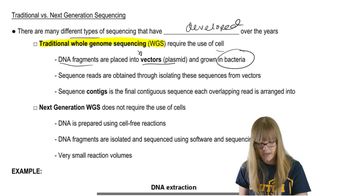Table of contents
- 1. Introduction to Genetics51m
- 2. Mendel's Laws of Inheritance3h 37m
- 3. Extensions to Mendelian Inheritance2h 41m
- 4. Genetic Mapping and Linkage2h 28m
- 5. Genetics of Bacteria and Viruses1h 21m
- 6. Chromosomal Variation1h 48m
- 7. DNA and Chromosome Structure56m
- 8. DNA Replication1h 10m
- 9. Mitosis and Meiosis1h 34m
- 10. Transcription1h 0m
- 11. Translation58m
- 12. Gene Regulation in Prokaryotes1h 19m
- 13. Gene Regulation in Eukaryotes44m
- 14. Genetic Control of Development44m
- 15. Genomes and Genomics1h 50m
- 16. Transposable Elements47m
- 17. Mutation, Repair, and Recombination1h 6m
- 18. Molecular Genetic Tools19m
- 19. Cancer Genetics29m
- 20. Quantitative Genetics1h 26m
- 21. Population Genetics50m
- 22. Evolutionary Genetics29m
8. DNA Replication
Overview of DNA Replication
Problem 13b
Textbook Question
List and describe the function of the ten subunits constituting DNA polymerase III. Distinguish between the holoenzyme and the core enzyme.
 Verified step by step guidance
Verified step by step guidance1
Identify the ten subunits of DNA polymerase III: α, ε, θ, β, τ, γ, δ, δ', χ, and ψ.
Describe the core enzyme of DNA polymerase III, which consists of the α, ε, and θ subunits. The α subunit is responsible for the polymerase activity, the ε subunit has 3' to 5' exonuclease activity for proofreading, and the θ subunit is thought to stabilize the ε subunit.
Explain the function of the β subunit, which forms a sliding clamp that increases the processivity of the DNA polymerase by holding it onto the DNA strand.
Discuss the role of the τ and γ subunits, which are part of the clamp loader complex. The τ subunit helps in dimerizing the core enzyme, while the γ subunit assists in loading the β clamp onto the DNA.
Differentiate between the holoenzyme and the core enzyme: The holoenzyme includes all ten subunits and is fully functional for DNA replication, while the core enzyme consists only of the α, ε, and θ subunits and is responsible for the basic polymerization and proofreading activities.
Recommended similar problem, with video answer:
 Verified Solution
Verified SolutionThis video solution was recommended by our tutors as helpful for the problem above
Video duration:
2mPlay a video:
Was this helpful?
Key Concepts
Here are the essential concepts you must grasp in order to answer the question correctly.
DNA Polymerase III Structure
DNA Polymerase III is a multi-subunit enzyme essential for DNA replication in prokaryotes. It consists of ten subunits, including the core enzyme made up of three main components: alpha (α), epsilon (ε), and theta (θ), which are responsible for polymerization and proofreading. The additional subunits, such as the clamp loader and sliding clamp, enhance the enzyme's processivity and stability during DNA synthesis.
Recommended video:
Guided course

DNA Structure
Holoenzyme vs. Core Enzyme
The holoenzyme of DNA Polymerase III refers to the complete functional form that includes the core enzyme along with additional subunits necessary for its full activity, such as the clamp loader complex. In contrast, the core enzyme consists solely of the essential polymerase components (α, ε, θ) and lacks the accessory factors that facilitate high processivity and efficient DNA replication.
Recommended video:
Guided course

Traditional vs. Next-Gen
Function of DNA Polymerase III Subunits
Each subunit of DNA Polymerase III plays a specific role in DNA replication. The alpha subunit is responsible for the polymerization of nucleotides, the epsilon subunit provides proofreading activity to correct errors, and the theta subunit stabilizes the epsilon subunit. Other subunits, like the beta clamp, encircle the DNA, allowing the polymerase to remain attached during replication, significantly increasing the enzyme's efficiency.
Recommended video:
Guided course

Functional Genomics

 5:02m
5:02mWatch next
Master Directionality with a bite sized video explanation from Kylia Goodner
Start learning



